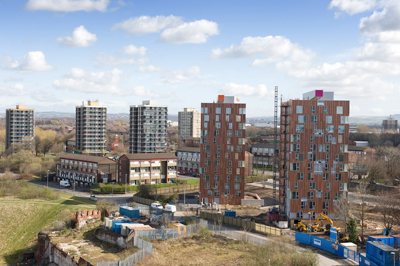You are in: Home page > Magazine Archive > New centrality in the suburbs

Valter Balducci
New centrality in the suburbs
The modification of Social Housing Estates
The reform of social housing estates carried out in the post-war period appears an opportunity in European cities to reorder the landscape of the urban outskirts. Analysis of the vast heritage of regeneration operations that has impacted these estates with the objective of transforming them into new centralities in the contemporary suburbs allows the marriage of different operational strategies that combine instances of continuity in the modern project, metamorphoses of settlement structure, and a redefinition of the relationship between city and nature.
The theme of the reform of social housing estates is intimately intertwined with the question of the twenty-first century city. If in Europe there seems to be a remote prospect of rapid urban development that also generates new city foundations, as is the case in various countries outside Europe, the modernization of European cities does have a fruitful opportunity available in the marriage of reform of its suburban neighbourhoods, containment of the urban encroachment of the countryside, and the preservation of its natural spaces. In particular, mass social housing estates built in the decades of post-war reconstruction appear fertile terrain to reshape and reorder settlement forms present in the urban junk-space. We might ask ourselves whether the mass housing estates now constitute recognizable urban facts and if they could become ordering poles with their own settlement specificity, virtually new urban centres for the chaotic territories of the suburbs. This opportunity is afforded not only by the provision of services that distinguish them from the surrounding fabric, or penalize them by their absence, but also by their morphology derived from the structured urban design on the basis of a project of values that belong to the culture of architectural modernism: services, settlement forms and public spaces which define that piece of city as a public city, (Di Biagi, 1986) regardless of its current ownership regime. An urban design developed over the long term, from the models of the first CIAM to the plethora of experiences of the nineteen-sixties, and makes these Housing in Europe estates recognizable with respect to the surrounding lots. More from the point of view of the energy renewal of the buildings or the architectural figures adopted, it is with respect to this urban design that we can observe the by-now ample heritage of realized urban regeneration which, in different ways, has experimented with renewed forms of centrality in the suburbs to understand their differences and identify strategies and ideals of transformation for them.
1. Accepting the presence of social housing estates as unitary and recognizable groupings of the contemporary city means accepting their settlement specificity. The search for their perpetuity in the suburban landscape opens up the first strategy: continuing the modern project keeping it as an urban fact that testifies a period of the city's history, but also updating it with a view to maintenance and completion of its settlement system, with attention to the values of its physical and material dimension and the preservation of its specific composition through a few monoliths (L. Routh, Three Towers in Manchester). The neighbourhood is conserved as an urban fragment, not merely as a testimony of a lost former theoretical unit, but also as a demand of a current situation. Where there is an emphasis on a monumentalizing of modern fragments (Kiefhof di Oud, Cité Frugès in Pessac by Le Corbusier), operations of urban regeneration seem in symbiosis with the so-called restoration of the modern aimed at rebuilding the original construction, typological and urban characteristics (Hawkins-Brown, Park Hill in Sheffield). However, beyond the heritage theme, the updating of a modern neighbourhood nonetheless includes actions to modify its existing state, with additions and subtractions at the building scale (Druot-Lacaton-Vassal, Bois le Prêtre in Paris), plus attention to the conservation of the specific urban composition of solitary volumes laid on the ground. This modernist landscape is also recognized in its ideal and practical incompleteness, confining the intervention of regeneration within the limits of conservation of its fundamental settlement principles, of its idea of city.
2. Criticism of the unmodifiable modernist distribution of volumes incapable of accepting evolutions and stratifications over time like that of social housing estates, constitutes a different perspective in operations to regenerate the suburbs. The idea is that existing urban material is in a provisional, improvable state, and that that city is ongoing, available for an intervention of modification towards a stable settlement layout founded on urban forms different from the original ones. Anticipated by Rodrigo Perez de Arce's project for the radical transformation of the Runcorn Housing estate (1982) (Perez De Arce, 1982), these projects set themselves the goal of consolidating the urban space, offering legibility and hierarchy by rediscovering the morphological complexity of streets and squares instead of the open space at the basis of modern monoliths, of working on the connexions and articulations within the context. Limited demolitions and new constructions make it possible to compose a new heterogeneous landscape of differentiated parts and a multiplicity of places (A. Grumbach, Les Minguettes in Vénissieux, Flamants in Marseilles), while the reform of the road network guarantees continuity with the surrounding urban fabric cancelling separateness and isolation (P. Panerai, Teissière in Grenoble). Densification, substitution, interruption and continuity allow a radical urban transformation (Lacaton-Vassal, Certé in Trignac), to which are no strangers interventions on the buildings, modified in their morphology, transforming monoliths into blocks, according to an inverse trajectory with respect to the “de l’îlot à la barre” route carried out by urban culture over the course of the twentieth century (Panerai, Castex, Depaule, 1980). A route realized in an exemplary way by the operations of remodelage introduced by Roland Castro (Lorient; Villeneuve-la-Garenne). Breaking up long linear volumes, reducing the height of towers, strengthening the morphologies of the buildings and adding new ones makes it possible to form blocks defined by streets but closed in by buildings that simulate the construction of the city by lots (Becker-Giseke-Mohren-Richard, Marzahn; KSP Architekten, “Neue Burg” in Wolfsburg; Lyoner Viertel in Frankfurt on Maine). Density is increased, or buildings are demolished to reconstruct them in another location (Von Schagen architekten, Florijn-Bijlmermeer in Amsterdam; Malvert in Nijmegen), with an effect that is urban sooner then architectural.
3. A different perspective is opened by those interventions that propose rethinking the land space starting from a renewed alliance with nature which is attributed a symbolic dimension and around which it is claimed to be able to again construct a united social environment. The social housing estate is impacted by techniques, values and ecological mythologies, in which the anxieties of environmental quality, energy self-sufficiency, and quality of the local product meet with a revision of lifestyles and ways of living. This redefinition of the relationship between city and nature is not limited to the ecologically advanced building, but presupposes a restructuring of fabric and a modification of suburban landscapes. Introducing density (residences, activities and services) into the grands ensembles is the suggestion of Studio 9, Bernardo Secchi and Paola Viganò to transform the suburbs of Paris into an éponge built upon the multiplicity of its nodes, monuments and centrality. The accent passes from the building (in any case ecological) to the open space, variously defined but nonetheless re-naturalized. What comes out is a conception of the public space that is virtually pastoral, populated by kitchen and didactic gardens, by bio-lakes and sweeping surfaces of countryside or primitive wood, vantage points for dwellings in which to try out new forms of comfort and luxury (Heren 5, Dillenburg; L. Routh, Saxton in Leeds). This redefinition of the land space of social housing estates allows the reconstruction of aspects that seemed definitively eclipsed, like a sort of new ecological functionalism and also a heightened sense of sharing and community.
Through strategies of patrimonialization, modification or redefinition of the relationship with nature, regeneration operations show the opportunities of these housing estates to become singular places, if not bona fide centres, of the suburbs. Born as isolated settlements, built as a break from any idea of stratification, these estates are now saved and re-issued into the urban life in the name of that same idea of stratification against which they were polemically erected.
Bibliography
Di Biagi P., (1986), La costruzione della città pubblica, in “Urbanistica”, n. 85
Di Biagi P., (a cura di) (2009), Città pubbliche. Linee guida per la riqualificazione urbana, Bruno Mondadori, Milano
Perez de Arce R., (1982), Runcorn trasformata. Una verifica sulla lunga durata, in “Lotus International”, n. 32,pp. 46-57
Panerai P., Castex J., Depaule JC., (1980) Formes urbaines. De l’ilot à la barre, Bordas, Paris
Castro R., Denissof S., (2005) [Re]modeler, métamorphoser, Le Moniteur, Paris
Le Grand Pari(s). Consultation internationale sur l’avenir de la métropole parisienne, Le Moniteur, Paris 2009, pp. 169-188
Valter Balducci, architect, and PhD in Architectural Composition at the IUAV, has been a researcher since 2001 at the Department of Architecture of the University of Bologna.
















